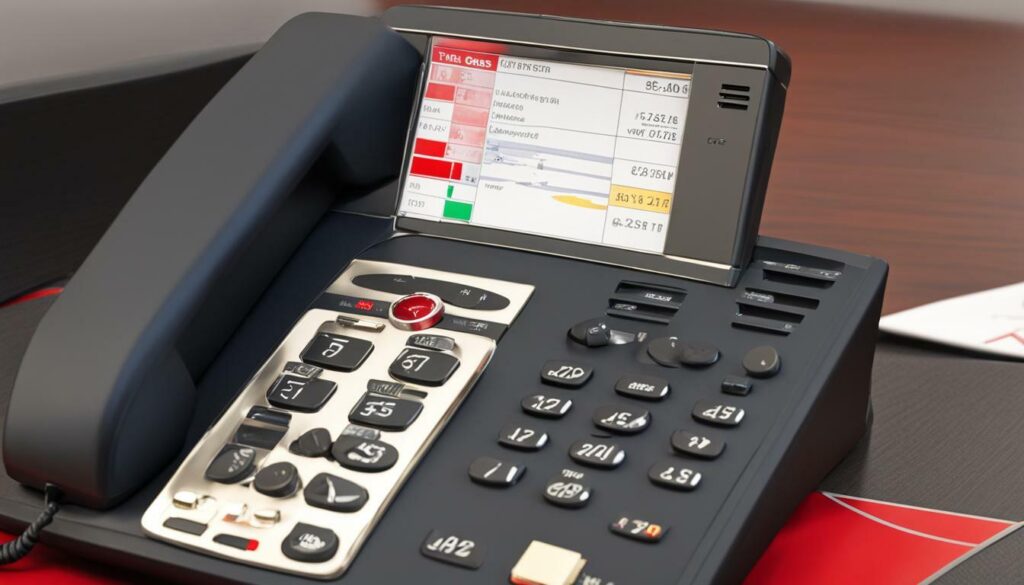Factual data: Troubleshooting (Dual Tone Multi-frequency) DTMF issue on SIP trunk is important for ensuring proper communication on VoIP (Voice over Internet Protocol) networks. DTMF tones are used for accessing features like voicemail and navigating IVR (Interactive Voice Response) systems. In VoIP, DTMF tones can be delivered in-band, or out-of-band via SIP or RTP signalling messages, or through SIP signalling negotiation.
DTMF issues can arise when there are conflicts between the DTMF settings on different components of the network. For example, if a switch is configured to detect in-band DTMF while an upstream provider requires out-of-band RFC2833 DTMF, problems can occur. This can result in errors such as an invalid mailbox or password when accessing voicemail systems.
To troubleshoot DTMF issues, it is recommended to check for packet loss, contact the provider to change DTMF settings, and ensure that the appropriate DTMF setting is used based on the codec being used (inband for G711 and rfc2833 for G729).
Twilio’s Elastic SIP Trunking offers dynamic trunking capacity for making and receiving phone calls through the PSTN (Public Switched Telephone Network). It supports various SIP methods and codecs, requires calls to be in E.164 format, and utilizes RFC 4733/2833 for DTMF events. The configuration steps for setting up a Twilio Elastic SIP Trunk involve provisioning the trunk through the Twilio Console, configuring termination and origination URIs, and ensuring compatibility with Twilio’s requirements.
- Troubleshooting DTMF issues is crucial for seamless communication on SIP trunks.
- DTMF tones are used for accessing voicemail and interacting with IVR systems.
- Conflicts between DTMF settings can cause issues, such as incorrect inputs or failed authentication.
- Checking for packet loss and ensuring appropriate DTMF settings are used can help resolve problems.
- Twilio’s Elastic SIP Trunking provides dynamic trunking capacity and supports RFC 4733/2833 for DTMF events.
Understanding DTMF and its Significance on SIP Trunk
When it comes to SIP trunking, the proper functioning of DTMF (Dual Tone Multi-frequency) tones is crucial for seamless communication. DTMF technology allows us to transmit numeric and symbolic information through the telephone network. In the context of SIP trunks, DTMF tones play a significant role in accessing features such as voicemail and interacting with IVR systems.
DTMF tones are used to input touch-tone commands during a call, allowing users to navigate through automated menus, enter passwords, and perform various actions. These tones are generated when we press the buttons on our phones, and the correct detection and transmission of these tones are essential for accurate communication.
In SIP trunking, DTMF tones can be delivered in different ways. They can be transmitted in-band, meaning they are carried within the voice stream, or out-of-band, using separate signaling messages. The method of delivery depends on factors like the chosen codec and network configuration.
Understanding the significance of DTMF and the potential compatibility issues that can arise on SIP trunks is essential for troubleshooting and ensuring smooth communication. In the following sections, we will explore common DTMF issues, factors affecting DTMF functionality, and effective troubleshooting techniques to address these issues.
Table: DTMF Delivery Methods
| Delivery Method | Description |
|---|---|
| In-Band | DTMF tones are transmitted within the voice stream, along with the audio signal. This method is suitable for codecs like G.711. |
| Out-of-Band | DTMF tones are carried separately from the voice stream through signaling messages. Methods like RFC 2833 and SIP INFO are commonly used for out-of-band delivery. |

Common DTMF Issues on SIP Trunk
Frequent DTMF (Dual Tone Multi-frequency) issues can disrupt communication on SIP (Session Initiation Protocol) trunks, causing frustrations for users. These issues can manifest in various ways, including incorrect inputs, failed authentication, or miscommunication with IVR (Interactive Voice Response) systems. Understanding and addressing these problems is crucial for maintaining a seamless and reliable communication experience on your SIP trunk.
One common DTMF issue is when DTMF signals are not recognized by the receiving end, resulting in incorrect inputs or failed interactions with IVR systems. This can occur due to compatibility conflicts between the DTMF settings on different components of the network, such as switches, PBX (Private Branch Exchange), or the service provider’s infrastructure. Misalignment in DTMF settings, such as using in-band DTMF when the provider requires out-of-band RFC2833, can lead to communication breakdowns.
To address DTMF issues on your SIP trunk, a systematic troubleshooting approach is recommended. Start by checking for packet loss, as this can affect the transmission of DTMF signals. If packet loss is detected, addressing network or internet connectivity issues may resolve the problem. It is also crucial to ensure that the correct DTMF setting is used based on the codec being used. For example, using in-band DTMF for G711 and RFC2833 for G729 is a common configuration.
When troubleshooting DTMF issues, it is important to engage with your service provider. They can assist in verifying the compatibility of your DTMF settings and offer guidance on any necessary configuration changes. By working closely with your provider and following best practices, you can effectively resolve DTMF issues and ensure seamless communication on your SIP trunk.
| Common DTMF Issues on SIP Trunk | Possible Solutions |
|---|---|
| Incorrect inputs or failed authentication | Check for compatibility conflicts in DTMF settings and align them with your provider’s requirements. Ensure proper codec configuration. |
| Miscommunication with IVR systems | Verify that the correct DTMF setting is used based on the codec being used. Configure in-band DTMF for G711 and RFC2833 for G729. |
| DTMF signals not recognized | Check for packet loss and address network or internet connectivity issues. Contact your service provider for assistance in verifying DTMF compatibility and making any necessary configuration changes. |

DTMF issues on SIP trunks can disrupt communication and hinder interactions with IVR systems. These issues often arise due to compatibility conflicts and misaligned DTMF settings. Troubleshooting DTMF issues involves checking for packet loss, ensuring the correct DTMF setting is used based on the codec being used and collaborating with your service provider to address compatibility concerns. By following these steps and best practices, you can effectively resolve DTMF problems and maintain seamless communication on your SIP trunk.
Factors Affecting DTMF on SIP Trunk
When troubleshooting DTMF issues on your SIP trunk, it is essential to understand the factors that can affect DTMF functionality. Several elements within your network infrastructure can contribute to problems with DTMF tones, resulting in issues like SIP trunk DTMF not working or DTMF tone problems. By identifying and addressing these factors, you can ensure seamless communication on your VoIP network.
One common factor is network congestion. When your network is congested, packets carrying DTMF tones may be delayed or lost, leading to incomplete or inaccurate tone detection. This can cause problems when accessing features like voicemail or interacting with IVR systems. Monitoring your network for congestion and taking appropriate measures to mitigate it can help improve DTMF functionality.
Incompatible DTMF settings can also be a major cause of problems. If the DTMF settings on different components of your network, such as switches or service providers, are not aligned, it can result in conflicts and failures in DTMF transmission. Ensuring that all the relevant parties involved in your SIP trunk have compatible DTMF settings is crucial for resolving DTMF issues.
Incorrect codec configurations can also impact DTMF functionality on your SIP trunk. Different codecs have varying methods of transmitting DTMF tones, and if the selected codec is not compatible with the DTMF settings on your trunk, it can lead to issues like SIP trunk DTMF not working. Verifying that your chosen codec aligns with the DTMF requirements of your network and making necessary adjustments can help resolve DTMF problems effectively.
Factors Affecting DTMF on SIP Trunk
| Factors | Impact |
|---|---|
| Network Congestion | Delays or loss of DTMF packets, leading to incomplete or inaccurate tone detection |
| Incompatible DTMF Settings | Conflicts and failures in DTMF transmission due to misalignment of settings |
| Incorrect Codec Configurations | Compatibility issues between the selected codec and DTMF settings, resulting in DTMF problems |

Understanding these factors and taking appropriate measures to address them is crucial in troubleshooting DTMF issues on your SIP trunk. By optimizing your network, ensuring compatibility between DTMF settings, and configuring appropriate codecs, you can resolve problems like SIP trunk DTMF not working or DTMF tone problems, ultimately enhancing the quality of your VoIP communication.
Troubleshooting DTMF Issues
When it comes to SIP trunking, smooth and uninterrupted communication is crucial. However, DTMF issues can sometimes disrupt this seamless experience. Troubleshooting DTMF (Dual Tone Multi-frequency) issues on a SIP trunk is essential for maintaining optimal functionality and ensuring that features like voicemail and IVR systems work seamlessly. In this section, we will guide you through the step-by-step process of troubleshooting DTMF issues on your SIP trunk.
Here are some key steps you can take to effectively diagnose and resolve DTMF problems:
- Check for packet loss: Packet loss can cause DTMF tones to be lost or delayed, leading to issues with accessing voicemail or navigating IVR systems. Monitoring your network for packet loss and addressing any underlying network issues can help resolve DTMF problems.
- Contact your provider: If you are experiencing persistent DTMF issues, it is advisable to contact your SIP trunk provider. They can assist in changing DTMF settings or provide insights into any network-related problems.
- Ensure compatibility with chosen codecs: Different codecs have different requirements for DTMF transmission. For example, G711 codecs typically use in-band DTMF, while G729 codecs use out-of-band RFC2833 DTMF. Ensure that the appropriate DTMF setting is used based on the codec being used in your network.
By following these troubleshooting steps, you can identify the root cause of DTMF issues and take the necessary measures to rectify them. Remember, seamless communication on your SIP trunk is achievable with the right approach to troubleshooting DTMF issues.
Example DTMF Troubleshooting Table
| Issue | Possible Cause | Resolution |
|---|---|---|
| Incorrect inputs during IVR navigation | Packet loss or incompatible DTMF settings | Check for packet loss, contact provider for DTMF setting changes, ensure compatibility with chosen codecs |
| Failed authentication for voicemail access | Conflicting DTMF settings or codec configurations | Verify DTMF settings on all components, ensure alignment with chosen codecs |
| Miscommunication with IVR systems | Network congestion or misconfigured DTMF settings | Diagnose and address network congestion, verify and adjust DTMF settings |

Configuring the correct DTMF settings on your SIP trunk is vital for ensuring seamless communication. DTMF (Dual Tone Multi-frequency) tones are essential for accessing features like voicemail and navigating IVR (Interactive Voice Response) systems. In this section, we will provide detailed insights into the different DTMF settings options and the importance of aligning these settings with your network’s requirements.
DTMF Settings Options
When it comes to DTMF settings, there are three primary options that you can choose from:
- In-Band: This method sends DTMF tones within the audio stream, using the same voice codec as the call. It is the most widely supported option but may result in audio quality degradation.
- Out-of-Band: This method transports DTMF tones outside the voice stream, typically using the RFC2833 protocol. It provides better audio quality and is recommended for SIP trunks.
- SIP INFO: This method carries DTMF tones in SIP signaling messages. It is less common and may have limited compatibility.
When configuring your DTMF settings, it is crucial to consider the requirements of your network and the equipment you are using. Different codecs and devices may have specific preferences for DTMF transport, so it’s important to ensure compatibility.
Importance of Proper Configuration
Properly configuring your DTMF settings on SIP trunks is essential for avoiding issues such as incorrect inputs or failed authentication. When the DTMF settings are not aligned, conflicts can arise, resulting in miscommunication with IVR systems or other features.
By aligning your DTMF settings with your network’s requirements and following industry best practices, you can ensure that your SIP trunk operates smoothly, allowing for seamless communication and efficient access to various features.

| DTMF Settings | Transport Method | Pros | Cons |
|---|---|---|---|
| In-Band | Within the voice stream | Widely supported | Potential audio quality degradation |
| Out-of-Band | Outside the voice stream (RFC2833) | Better audio quality | May have limited compatibility |
| SIP INFO | In SIP signaling messages | – | Less common, limited compatibility |
Properly configuring your DTMF settings on SIP trunks is crucial for ensuring optimal communication. By understanding the different options available and aligning them with your network’s requirements, you can overcome DTMF issues and ensure a seamless experience for users.
Recommendations for DTMF Troubleshooting: Resolving DTMF Issue on SIP Trunk
When it comes to troubleshooting DTMF issues on your SIP trunk, following a systematic approach can help you identify and resolve any problems effectively. Here are some recommendations to consider:
- Check for packet loss: DTMF tones can be sensitive to packet loss, so it’s important to monitor your network for any issues. High packet loss can result in DTMF tones not being recognized properly, leading to communication problems.
- Ensure DTMF settings compatibility: Different components of your network, such as switches, PBXs, and providers, may have different requirements for DTMF settings. It’s crucial to ensure that these settings are compatible and properly configured. For example, if your upstream provider requires out-of-band RFC2833 DTMF, make sure your equipment is set to the same.
- Partner with a reliable service provider: Choosing a reputable and experienced SIP trunking provider can greatly reduce the chances of encountering DTMF issues. A reliable provider will have robust network infrastructure and knowledgeable support teams to address any problems that may arise.
- Utilize appropriate DTMF settings based on codecs: The choice of codec can impact DTMF functionality. For G711, in-band DTMF is often recommended, while G729 typically requires out-of-band RFC2833 DTMF. Ensure that the appropriate DTMF setting is used based on the codec being used in your network.
By implementing these recommendations, you can improve the overall quality of your SIP trunking experience and minimize the occurrence of DTMF problems. Remember to regularly monitor your network, stay updated on industry standards, and work closely with your service provider to ensure seamless communication on your SIP trunk.
Table: Troubleshooting DTMF Issues
| Issue | Potential Cause | Resolution |
|---|---|---|
| Incorrect DTMF inputs | Packet loss, incompatible DTMF settings | Check for packet loss and ensure DTMF setting compatibility |
| Failed authentication | Incorrect password, misconfiguration | Verify password and check configuration settings |
| Miscommunication with IVR systems | Incompatible DTMF settings, codec mismatch | Ensure DTMF settings alignment and codec compatibility |
By addressing these common issues and following the troubleshooting recommendations, you can effectively resolve DTMF problems on your SIP trunk and ensure smooth and uninterrupted communication.
Factual data: Troubleshooting DTMF (Dual Tone Multi-frequency) issues on an SIP (Session Initiation Protocol) trunk is important for ensuring proper communication on VoIP (Voice over Internet Protocol) networks. DTMF tones are used for accessing features like voicemail and navigating IVR (Interactive voice Response) systems. In VoIP, DTMF tones can be delivered in-band, or out-of-band via SIP or RTP signalling messages, or through SIP signalling negotiation.
DTMF issues can arise when there are conflicts between the DTMF settings on different components of the network. For example, if a switch is configured to detect in-band DTMF while an upstream provider requires out-of-band RFC2833 DTMF, problems can occur. This can result in errors such as an invalid mailbox or password when accessing voicemail systems.
To troubleshoot DTMF issues, it is recommended to check for packet loss, contact the provider to change DTMF settings, and ensure that the appropriate DTMF setting is used based on the codec being used (inband for G711 and rfc2833 for G729).
Twilio’s Elastic SIP Trunking
Twilio’s Elastic SIP Trunking offers dynamic trunking capacity for making and receiving phone calls through the PSTN (Public Switched Telephone Network). It supports various SIP methods and codecs, requires calls to be in E.164 format, and utilizes RFC 4733/2833 for DTMF events. The configuration steps for setting up a Twilio Elastic SIP Trunk involve provisioning the trunk through the Twilio Console, configuring termination and origination URIs, and ensuring compatibility with Twilio’s requirements.

| DTMF Issue | Description | Solution |
|---|---|---|
| SIP trunk DTMF not working | DTMF tones are not detected or recognized on the SIP trunk. | Contact the service provider to verify DTMF settings and ensure compatibility with the chosen codecs. Check for any network issues such as packet loss or congestion. |
| DTMF compatibility issues on SIP trunk | Conflicts between the DTMF settings on different components of the network. | Check and align the DTMF settings on all components of the network, including switches, routers, and service providers. Ensure consistency with the chosen codecs and protocols. |
By following these troubleshooting steps and utilizing the capabilities of Twilio’s Elastic SIP Trunking, you can effectively address and resolve DTMF issues on your SIP trunk, ensuring seamless communication on your VoIP network.
Setting Up a Twilio Elastic SIP Trunk with DTMF Support
Setting up a Twilio Elastic SIP Trunk with proper DTMF support is crucial for seamless communication on your VoIP network. Twilio’s Elastic SIP Trunking offers dynamic trunking capacity and supports various SIP methods and codecs. By following the steps outlined below, you can ensure that your SIP trunk is configured correctly to handle DTMF events and prevent any potential issues.
Provisioning the Trunk
The first step in setting up a Twilio Elastic SIP Trunk with DTMF support is to provision the trunk through the Twilio Console. This involves creating a new SIP trunk, providing the necessary configuration details such as authentication credentials, and specifying the termination and origination URIs. It is important to carefully enter all the required information accurately to ensure the trunk is correctly provisioned.
Configuring DTMF Settings
Once the trunk is provisioned, you need to configure the DTMF settings to ensure compatibility with Twilio’s requirements. Twilio utilizes RFC 4733/2833 for DTMF events, so it is essential to align your settings accordingly. This typically involves selecting the appropriate DTMF method, such as in-band or out-of-band, and configuring the corresponding parameters to match Twilio’s specifications.
Testing and Troubleshooting
After configuring the DTMF settings, it is essential to thoroughly test the trunk to ensure proper DTMF functionality. Place test calls and verify that DTMF tones are successfully transmitted and recognized by the receiving end. If any issues arise, it is recommended to consult Twilio’s documentation for troubleshooting steps or reach out to their support team for assistance in resolving any DTMF-related problems.
By following these steps, you can set up a Twilio Elastic SIP Trunk with DTMF support, ensuring seamless communication and addressing any potential DTMF issues on your VoIP network.
| SIP Trunk Configuration Steps |
|---|
| 1. Provision the trunk through the Twilio Console |
| 2. Enter the required configuration details |
| 3. Specify the termination and origination URIs |
| 4. Configure the DTMF settings |
| 5. Test the trunk for proper DTMF functionality |

When it comes to troubleshooting DTMF (Dual Tone Multi-frequency) issues on SIP (Session Initiation Protocol) trunks, following best practices can help ensure smooth communication on your VoIP (Voice over Internet Protocol) network. Here are some key recommendations to resolve DTMF problems:
- Regularly monitor your network: Keeping a close eye on your network for any abnormal behavior or performance issues can help identify potential DTMF problems early on. Monitor for packet loss or excessive latency that may impact DTMF transmission.
- Stay updated on industry standards: Stay informed about the latest industry standards and best practices for DTMF transmission. This includes staying up-to-date on the recommended DTMF settings for different codecs and ensuring compatibility across your network.
- Configure your equipment correctly: Properly configuring your network equipment, including switches, routers, and SIP endpoints, is crucial for optimal DTMF functionality. Ensure that the correct DTMF settings are applied based on the chosen codecs, such as in-band for G711 and RFC2833 for G729.
By implementing these best practices, you can proactively address DTMF issues on your SIP trunk and maintain reliable communication throughout your VoIP network.

Summary:
| Best Practices for Troubleshooting DTMF Issues on SIP Trunks |
|---|
| Regularly monitor your network |
| Stay updated on industry standards |
| Configure your equipment correctly |
Following these best practices will help you effectively troubleshoot and resolve DTMF problems, ensuring seamless communication on your SIP trunk.
Ensuring Seamless Communication with DTMF on SIP Trunks
Frequent DTMF issues on SIP trunks can disrupt communication, leading to frustration and hampering productivity. To resolve these troubles and ensure seamless communication, it is crucial to follow a systematic troubleshooting approach.
First, check for packet loss, which can degrade the quality of DTMF transmission. High levels of packet loss can result in incomplete or inaccurate DTMF tones, leading to failed authentication or miscommunication with IVR systems. Monitoring your network regularly and addressing any packet loss issues can significantly improve DTMF functionality.
Next, contact your SIP trunk provider to discuss DTMF setting changes. Incompatible or misconfigured DTMF settings can cause issues, such as incorrect inputs or failed authentication. Collaborate with your provider to ensure that the appropriate DTMF setting is used based on the chosen codecs in your network. For example, in-band DTMF is suitable for G711, while RFC2833 is recommended for G729.
Lastly, ensure compatibility with your chosen codecs. Different codecs may require specific DTMF settings to function correctly. By aligning your DTMF settings with the requirements of your codecs, you can ensure seamless communication and avoid compatibility conflicts that can lead to DTMF issues.
Table: Troubleshooting DTMF Issues on SIP Trunks
| Step | Action |
|---|---|
| 1 | Check for packet loss |
| 2 | Contact your SIP trunk provider for DTMF setting changes |
| 3 | Ensure compatibility with chosen codecs |
By following these troubleshooting steps and best practices, you can resolve DTMF issues on your SIP trunk and ensure seamless communication. Regularly monitoring your network, staying updated on industry standards, and configuring your equipment properly are key to maintaining optimal DTMF functionality and enhancing the overall quality of your VoIP network.

Finding and resolving DTMF issues on SIP trunks is crucial for maintaining reliable communication on VoIP networks. DTMF tones play a vital role in accessing features like voicemail and navigating IVR systems, ensuring a seamless user experience.
When troubleshooting DTMF issues, it is important to identify conflicts in DTMF settings across different network components. Incompatible settings can lead to errors in accessing voicemail or interacting with IVR systems. To address these issues, checking for packet loss, contacting your provider to change DTMF settings, and aligning the appropriate DTMF setting with the codec being used can greatly improve functionality.
Twilio’s Elastic SIP Trunking is a reliable solution for businesses seeking dynamic trunking capacity and compatibility with various SIP methods and codecs. By following the recommended configuration steps, such as provisioning the trunk through the Twilio Console and ensuring compliance with Twilio’s DTMF requirements, you can set up a Twilio Elastic SIP Trunk with proper DTMF support and enhance the overall quality of your VoIP network.
























